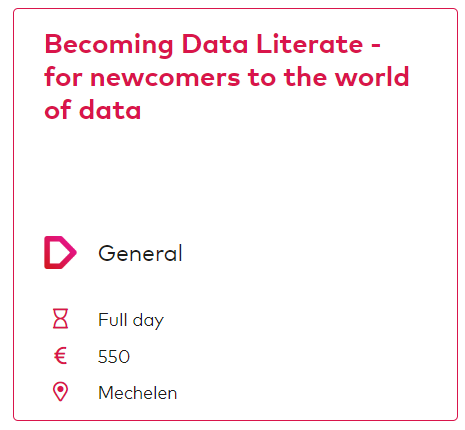Do You Speak Data🤔? A Case for Data Literacy
6 June 2023

Introduction
In today's world, data literacy has become a crucial skill set for individuals and organizations alike. The ability to read, work with, analyse, and argue with data is vital in leveraging its potential advantages. With our vast experience in helping clients to get the most out of their data, we believe data literacy is truly decisive for organisations that want to succeed. In this blog post we explore the importance of data literacy, emphasize the need for collaboration between data consumers and data producers within a data fluent culture and a well-established data product ecosystem.
The Framework
To get a bigger insight in what data literacy is and how it works, we like to introduce a framework for data literacy in organizations. This framework separates data consumers and data producers on one axis and individuals and organizations on the other. For data to become an advantage, all quadrants of the framework need to work in Harmony.

Data Consumers
The upper left quadrant represents data consumers. By this we mean the individuals who utilize data products such as dashboards to make informed decisions. Managers are highlighted as prime examples of data consumers who must consider all available information before taking action. A skilled data consumer requires a basic understanding of statistics and deep knowledge of their respective sector. To become data literate it is important to know: where the data comes from, what can be learned from the data and what can be done with the data?
Data Producers / Data Authors
Opposite to data consumers, the higher right quadrant represents data producers responsible for building data products for consumption. Data analysts and data scientists typically fulfil this role, requiring extensive statistical knowledge, a strong programming foundation, and the ability to convey a coherent story. The producer must decide what data is most important to focus on to answer the questions at hand, and how to optimally harness and depict data to inform thinking and action. Storytelling is key for data producers to enable data consumers to quickly make sense of the presented information.
Blurring Roles
In some cases, individuals may occupy both the data consumer and data producer roles, with various roles like business analysts or translators positioned in the middle. These individuals act as intermediaries, articulating the needs of data consumers to ensure that the data products developed by data producers align with expectations.
Data Fluent Culture
The bottom left quadrant focuses on cultivating a data fluent culture within organizations. While access to the same talent pool is available for hiring, we can’t overvalue the importance for companies to foster a data literate environment. This culture can be created by the leaders in the organization. Leaders who routinely make data driven decisions, set an example for the rest of the organization to follow. Within a data fluent culture, data is used to support decisions and set priorities. And last but not least, training employees is crucial to cultivate a data fluent culture.
Data Product Ecosystem
The last part of the framework addresses the data product ecosystem, emphasizing the significance of well-defined processes, tools, and standards. The presence of a quality data platform is highlighted as a prerequisite before building models and dashboards. Data engineers play a vital role in establishing robust data governance and quality checks to meet the increasing complexity and regulations surrounding data. As an organisation, investing in a quality data platform pays off.
Conclusion
The interdependence of all four parts of the framework is crucial to establish a data literate organization. While the visual representation may appear simplistic, there are definitely challenges involved. These challenges can go from setting the roles of data consumers and data producers and establishing a data fluent culture, to the significance of a well-functioning data product ecosystem.
There are a few things you can do as an organisation towards better data literacy:
- Define training and skills needed
- Create a data product inventory
- Set a technology roadmap
Does this seem overwhelming? Datashift can assist you, from training to strategic advice, we love to share our experience! Do not hesitate to reach out and let us know your data challenge.

The framework presented here was loosely adapted from the book "Data Fluency: Empowering Your Organization with Effective Data Communication" which you can buy here.
